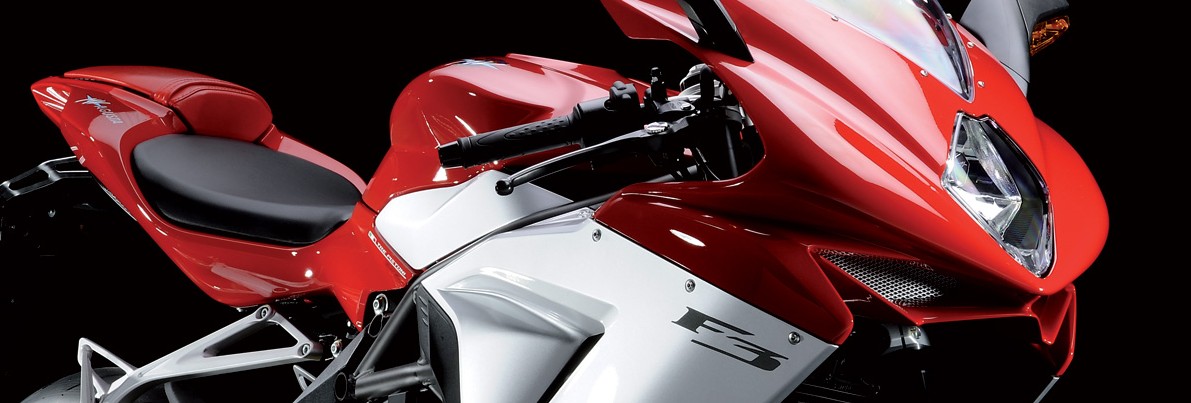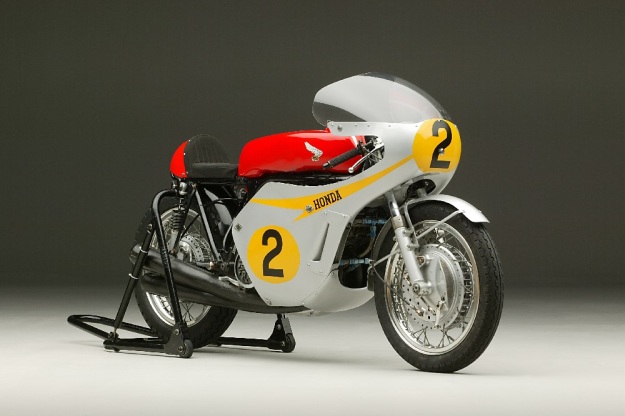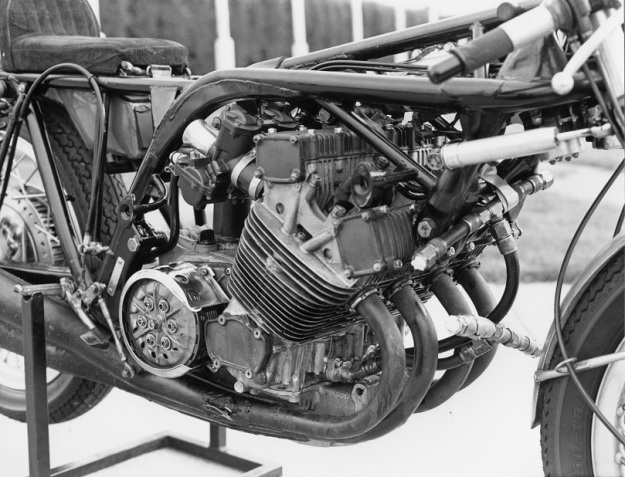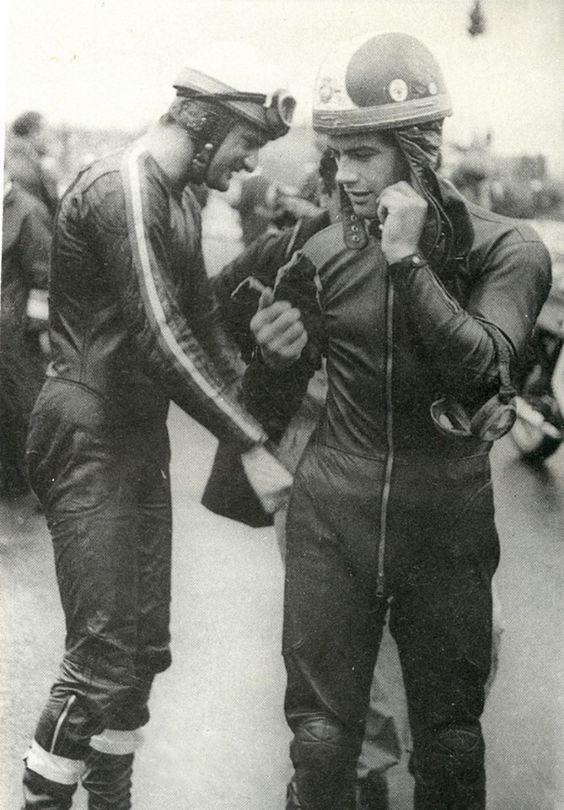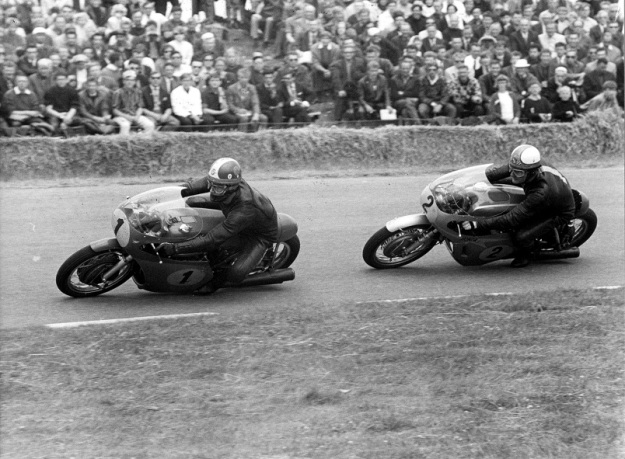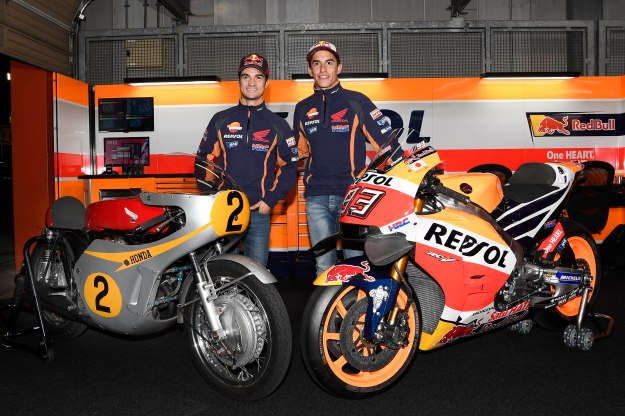
Dani Pedrosa and Marc Marquez pose with the 1966 Honda RC181 and the 2016 RC213V at Motegi in Japan.
It was perhaps fitting that Marc Marquez collected his third MotoGP World Championship at Honda’s own circuit at Motegi in Japan, as 2016 celebrates 50 years since Honda first entered the premier class of Grand Prix motorcycle racing.
What is also appropriate is the fact that Marquez achieved this on the recalcitrant 2016 RC213V. Although an improvement over the 2015 edition, a change to the new Michelin control tyres as well as the new control software, tossed in, even more, variables for the Repsol Honda team to equate. But the key this year to Marquez’s success has been his determination to finish every race and has shown the kind of maturity, at just 23 years of age, that no doubt is worrying to his rivals. Honda’s first foray into the 500cc (MotoGP) class with the RC181, coincidentally suffered handling issues as well.
Honda, of course, was the first Japanese motorcycle manufacturer to enter into the Grands Prix in 1959 at the Isle of Man TT in the 125cc category. After considerable success in the lower capacity classes, Honda then took the plunge by entering a 500cc machine in the premier class for 1966. Although rumours in the paddock suggested that like the multi-cylinder four-strokes Honda had produced in the smaller capacity classes, the 500cc machine could potentially have a six-cylinder or even a V-8 power plant.
However, it was a more conventional transverse air-cooled four-cylinder engine, with twin overhead camshafts and four-valves per cylinder, that fronted the grid. The RC181 boasted a very competitive 85hp at 12,000rpm and weighed in at 154kg using the engine as a stressed member. It was entrusted to Rhodesian, Jim Redman, Honda’s six times world champion (two 250cc and four 350cc class titles) to take on the might of MV Agusta and the talents of its rising star Giacomo Agostini.
Redman took the RC181 to a stunning victory on debut at the German Grand Prix at Hockenheim and followed that up with a win at the next round in Holland at the Dutch TT. Honda had also enticed its former 250cc World Champion, Mike Hailwood, back to the fold, and although his priority was to be the 250cc and 350cc categories, Hailwood rode the new machine for the first time in Holland and was leading the race when a false neutral caused him to crash. Nonetheless, it appeared MV Agusta’s monopoly on the class was about to end.
The RC181 though flattered to deceive, and Redman crashed in atrocious conditions during the next round at Spa in Belgium. He badly broke his arm and promptly retired from racing, leaving Hailwood to try and retrieve the championship challenge. Although Hailwood notched up three wins in Czechoslovakia, Ulster and the Isle of Man and a second place in Finland, mechanical problems at the other four rounds handed the riders title to Agostini and the new three-cylinder MV Agusta. Honda was left with the consolation of winning the manufacturer’s trophy with a motorcycle that Hailwood could only describe the handling as, “Bloody awful!”

Hailwood’s Honda wore the number 1 plate in 1966 after winning the 500cc crown for MV Agusta in 1965.
Both Honda and Hailwood returned for the 1967 season with an updated RC181. The off-season saw the Honda now developing a healthy 93bhp at 12,650rpm with its weight reduced 13kg to 141kg with the extensive use of magnesium in the engine. Mike had flown to Japan during the off-season to test the 1967 machines and was horrified to discover the promised new chassis for the RC181 was non-existent and demanded to take an engine back to England to have a chassis built in Europe that might solve the severe handling problems.
The Japanese though refused to let Hailwood race the new chassis in the Grands Prix, but instead “beefed up” the existing RC181 frame which used the engine as a stressed member. Mike did enter the HRS (Hailwood Racing Special) at some non-championship races and even practiced on it for the first Grand Prix of the season at Hockenheim but reverted to the factory RC181 for the race and was leading when the crankshaft broke handing Agostini the win.
The next race was the TT at the Isle Of Man, a race that became one of the all-time classics in Grand Prix racing history. During their titanic struggle, the lead swapped back and forth for five of the six laps of the 37.5mile course (60.3km) until the chain broke on Agostini’s MV. Hailwood cruised to victory and had set a new outright lap record of 108.77mph (175kph), which stood for almost a decade.
The next weekend Agostini and the improving MV outpaced Hailwood and the Honda at Spa in Belgium, and at the Sachsenring in East Germany, gearbox problems forced Mike to retire with Agostini claiming victory. The Brno circuit in Czechoslovakia was next with Hailwood finishing 17.8 seconds ahead of his nemesis on the MV Agusta triple. But a fall at Imatra in Finland on a wet track shifted momentum once more to Agostini.
The roles were reversed again at the Dundrod circuit in Ulster with ‘Ago” retiring and Hailwood winning. The whole season now pivoted on the penultimate race of the season at the Nations Grand Prix in MV Agusta’s own backyard at Monza in Italy. At last, it looked like Honda would achieve their ambition as Hailwood led Agostini by 16 seconds with three laps to go only to have certain victory stolen from him by a gearbox that became stuck in top gear. Agostini flashed by to win by 13.2 seconds and take the title a second year in a row.
Although Hailwood won again at the final round at Mosport in Canada, beating “Ago” home by a massive 37.7 seconds, it was of no avail. Both riders had accumulated five wins apiece, but “Ago” took the title due to three-second place finishes to Hailwood’s two. There was no consolation prize for Honda either as MV Agusta also took home the manufacturers title.
Honda withdrew from the Grands Prix at the end of 1967, but this was just a prelude of what was to come. The Japanese company returned to the premier class of Grand Prix motorcycle racing in 1979 with the ill-fated NR500 four-stroke racer and won the first of their many rider’s titles in 1983 with Freddie Spencer and the NS500 two-stroke.
Those frustrating seasons of 1966 and 1967 for Honda, must now seem a lifetime away. As this is written, the Japanese manufacturer has accrued a staggering 279 race victories and 39 riders and Constructors World Championships.
Words Geoff Dawes © 2016.Images courtesy of Honda and http://www.formulamoto.es.
YouTube Video courtesy of Pathe.
